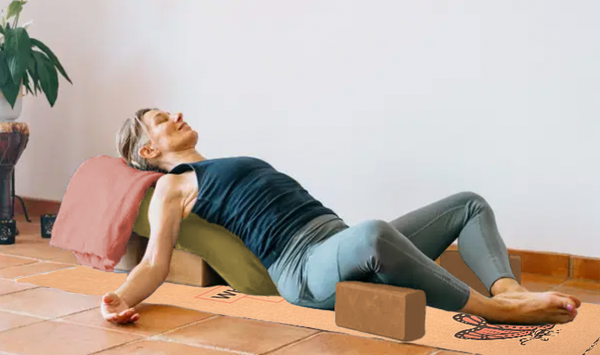15-Minute Yoga Nidra for Better Sleep
Scrolling in bed might feel harmless, but it’s one of the quickest ways to sabotage your night. Blue light and endless feeds keep the brain buzzing when it should be winding down. Tonight, instead of doom-scrolling, give yourself 15 minutes of Yoga Nidra, a simple, guided rest practice that helps calm the nervous system and prepare the body for sleep.
“Your evening routine matters more than willpower. Light is the strongest signal to your body clock.” — Sleep medicine specialist
At My Yoga Essentials, we believe better sleep doesn’t have to come from a bottle. Small, intentional rituals like Yoga Nidra can train your mind and body to rest more deeply without forcing or striving.
What Yoga Nidra Is (and Isn’t)
Yoga Nidra, sometimes called “yogic sleep,” is a guided practice of rest. You lie down, close your eyes, and follow a calm series of steps like a body scan and slow breath work that shift the body toward relaxation.
“Yoga Nidra is about non-doing. You’re not trying to fall asleep; you’re letting the body remember how.” — Yoga nidra teacher
It’s not exercise, and you won’t break a sweat. Instead, think of it as a “reset button” for your nervous system. Many people use it at night to prepare for sleep, but it also works beautifully as a midday recharge.
A 15-Minute Script You Can Use Tonight
Here’s a simple flow you can follow. All you need is a quiet space, something to lie on, and maybe a pillow or blanket for comfort.
Setup (1 min):
Lie on your back with a pillow under your knees or behind your head if needed. Close your eyes; cover them lightly if you like.
Body Scan (5 min):
Bring awareness slowly from the crown of your head down to your toes. Notice each part of your body and invite it to soften the forehead, jaw, shoulders, arms, belly, hips, legs, and finally, the feet.
Breath Awareness (3 min):
Breathe in through the nose for a gentle count of four, then exhale for a slow count of six. Let the breath guide your nervous system into calm.
Imagery + Intention (3 min):
Picture a peaceful scene like a quiet beach, a safe room, a place you love. Then silently repeat a kind phrase such as “I am safe and ready to rest” or “I welcome sleep tonight.”
Return (3 min):
Slowly bring awareness back to the room. Wiggle your fingers and toes. Roll gently to one side before sitting up, or allow yourself to drift into sleep if it feels natural.
Tip: You don’t have to memorize all of this. Keep a printed copy on your nightstand, or record yourself reading it aloud in a calm voice.
A Pre-Bed Routine That Helps
Yoga Nidra is powerful, but it works even better when paired with simple evening habits:
- Screen-off time: Shut down phones, tablets, and TVs 30–60 minutes before bed.
- Dim the lights: Light is a signal to your body clock. Softer, warmer lighting helps the brain release melatonin.
- Cool, dark, quiet room: The basics of sleep hygiene recommended by the American Academy of Sleep Medicine.
- Optional warm shower: The drop in body temperature afterward signals the body to rest.
- Skip the late-night coffee, alcohol, or heavy meals: They’re common culprits for restless sleep.
If Sleep Still Feels Hard
If you’ve struggled for months with falling asleep or staying asleep, you’re not alone. Experts recommend Cognitive Behavioral Therapy for Insomnia (CBT-I) as the gold-standard treatment for chronic insomnia. Yoga Nidra can be a wonderful complement, but if sleep issues are persistent, professional guidance is worth it.
Seek medical care if:
- You or your partner notice loud snoring, gasping, or pauses in breathing.
- You experience restless legs or frequent nighttime awakenings.
- Insomnia continues despite good habits.
Resources:
Troubleshooting Common Roadblocks
- Mind racing: Try Nidra 60–90 minutes before bed, not right at bedtime. Journaling beforehand can also help clear mental clutter.
- Fidgeting or aches: Add pillows under your knees, behind your neck, or try side-lying with support. Comfort is key.
- Numbness in limbs: Adjust arm and leg positions; small pillows can relieve pressure points.
- Falling asleep immediately: That’s fine! The practice still supports rest, but you might also try a shorter version during the day to get the mental reset benefits.
FAQ
When should I do Nidra?
One to two hours before bed is ideal. You can also use a short version in the afternoon for a reset.
Can I fall asleep during it?
Yes. Many people drift off, and it still helps calm the nervous system.
Is Nidra the same as meditation?
They’re related, but not identical. Meditation often involves focus and awareness; Nidra is about guided deep rest.
What if I snore?
Try lying on your side or with your head slightly elevated. If snoring is frequent or loud, check with a healthcare provider.
How often should I practice?
Three to seven times a week is common. Consistency matters more than length.
Final Thought
At My Yoga Essentials, we’ve seen how small, mindful rituals can make a big difference. Fifteen minutes of Yoga Nidra may not sound like much, but it’s often enough to shift your body from wired to restful. Tonight, trade the endless scroll for a practice that actually sets you up for the sleep you’ve been craving.


